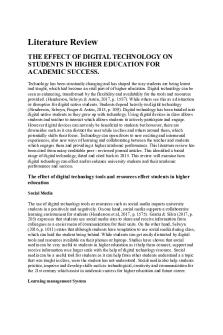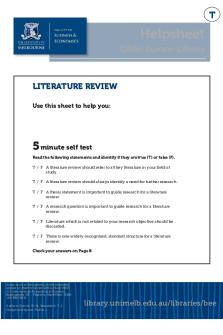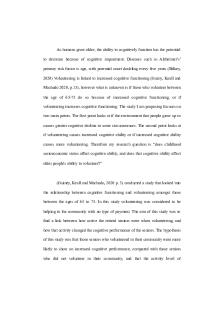Literature Review- SRAP1001 PDF

| Title | Literature Review- SRAP1001 |
|---|---|
| Course | Social Research and Society |
| Institution | University of New South Wales |
| Pages | 7 |
| File Size | 177.9 KB |
| File Type | |
| Total Downloads | 187 |
| Total Views | 650 |
Summary
Write a literature review about the mental health of prisoners in Australia, focusing on the impacts of poor mental health for prisoners and Australian society.The Mental Health Status of Indigenous Persons in Prisons, and the impact on Australian Society A Literature reviewIntroductionThe mental he...
Description
Write a literature review about the mental health of prisoners in Australia, focusing on the impacts of poor mental health for prisoners and Australian society.
The Mental Health Status of Indigenous Persons in Prisons, and the impact on Australian Society A Literature review
Introduction
The mental health status of indigenous prisoners has undergone much debate in the Australian community. Historical contexts of colonization and ongoing socioeconomic disadvantages such as high rates of poverty have had a profound effect on Indigenous health. In order to address the challenging mental health issues experienced throughout prisons nation-wide by Aboriginal and Torres Strait Islander groups, it is critical that culturally sensitive interventions and resources are implemented and readily available. Medical personnel must work to 'untangle the complex interplay of culture, context and clinical significance’ (Hunter 2014: 26). This could include the introduction of culturally sensitive policies and interventions; such policies and interventions must imperatively be well informed of the environmental settings that these groups have endured for years (Guerin and Guerin 2012: 555). The lack of evidence provided through epidemiological studies to display the detrimental effects of imprisonment specifically on Aboriginal and Torres Strait Islander groups, highlights a serious cause for concern. This demonstration of a lack of both compassion and understanding for such minority groups must be addressed and immediately tackled by governmental bodies. The limited empirical evidence that does exist will be explored in this review through the themes including the prevalence of disorders among indigenous prisoners, resourcing factors (lack of clinical help) and societal factors (lack of cultural sensitivity). The articles that display these points will interplay with each other, discussing critical gaps that must be taken into consideration by both the general public and medical health services.
1
High prevalence of disorders for Aboriginal prisoners
The incarceration of Aboriginal prisoners is without a doubt increasing dramatically. Another concern that is closely associated with the aforementioned point is the prevalence of mental illnesses being consistent in Aboriginal inmates. Numerous studies have highlighted the likelihood of mental illnesses among Indigenous men and women compared to the general community. Heffernan, Anderson, Davidson and Kinner (2015) study of the impact of posttraumatic stress disorder on indigenous inmates highlights issues of concern. Using both a diagnostic instrument and both qualitative/quantitative methodologies in their research survey, they were able to identify the correlation between post-traumatic stress disorder and mental illnesses. The results included: ‘Individuals diagnoses of PTSD were significantly more likely than those without a PTSD diagnosis to suffer from mental disorder… among those diagnosed with PTSD, 31.2% were also diagnosed with another anxiety disorder, 32.8% with depression, 24.6% with psychosis, and 75.4% with a substance use disorder’ (Heffernan et al. 2015: 526). Heffernan et al. (2015) study also identified the prevalence of PTSD among indigenous men and women to be higher compared to the general community, which resulted in the high occurrence of suicidal thoughts and depressive disorders while in custody (Heffernan et al. 2015: 527). The study of Ober, Dingle, Clavarino, Najman, Alati and Heffernan (2013) also makes reference to this using a cross-sectional design survey in order to identify the prevalence of substance use in Indigenous prisons. The results concluded that substance abuse of alcohol and drugs was the correlating factor between recidivism and mental illnesses. However when investigating Doolan, Najman and Cherney (2012) study of indigenous youth entering detention Centre’s, results varied in relation to mental illnesses and substance use. It was confirmed that indigenous young people are diagnosed with substance disorder, however, less likely identified to be suffering from mental illnesses (Doolan et al. 2012: 900). Thus it can be established that substance use is a concerning factor for Indigenous persons and imprisonment. However, as participants were surveyed and asked to state health issues that they experienced prior to incarceration, it created notions of bias in the reports (gaps in the methods).
2
Resourcing factors: Lack of clinical help
The lack of clinical resources in addressing the mental issues for Indigenous persons in or out of custody is the correlating factor between reoffending in Australian society. Mental health nurses must be included to work alongside indigenous prisoners or exprisoners from an early stage in order to achieve successful results and ‘allow the person to develop confidence and make the decisions needed to improve their levels of health’ (Doyle, Cleary, Usher and Hungerford 2016: 397). They are perceived as a vital component in assessing the health status of indigenous persons, however accessibility to patients in custody is very limited for them. This leads to the inability of addressing the mental inequalities that these groups endure on a day-to-day basis (Treloar 2012: 34). The lack of clinical resources can be identified in Bartels (2012) study on Indigenous women in custody. Bartels (2012) identifies that indigenous women in custody are ‘11 times more likely to show symptoms of psychiatric and mental disorders compared to the general community’ (Bartels 2012: 11). Thus highlighting the lack of clinical health treatment to address the high prevalence of mental illnesses among indigenous women. Kinner, Dietze, Gouillou and Alati (2012) also makes reference to this in relation to the high prevalence of substance use for indigenous prisoners. The study mentions that interventions held to eradicate the use of alcohol should ‘not be limited to manualised, abstinence-oriented education programs in prison, but should involve individualized support that continues after the prisoner has returned to the community’ (Kinner et al. 2012: 332). This is justified as a link between recidivism and alcohol related problems, however such research on the topic is limited and requires further longitudinal studies. Heffernan et al. (2015) study also analyses the lack of services available to indigenous persons before and after incarceration. The study recorded low levels of access to mental health services before individuals were imprisoned, therefore advocated the importance of implementing these services post-release to close the gap of inequality experienced in this disadvantaged group (Heffernan et al. 2015: 528). Despite this, all studies do advocate the implementation of clinical resources and early intervention towards the suffering symptoms of mental illnesses.
3
Societal factors: Lack of cultural sensitivity
For hundreds of years, Indigenous persons have endured discrimination and a loss of connection between their own land and communities. As their environment was constantly threatened, it also resulted in their identity being stripped away (Doyle et al. 2016: 397). This form of decolonization has led to serious implications including isolation, which can result in drug and alcohol abuse. There is a conception of the inability of clinical workers to understand the mental state of indigenous persons, specifically to issues of ‘powerlessness, discrimination and intergenerational trauma’ (Shepherd and Phillips 2016: 307). Mental health care must be able to address the consequences of the social injustice experienced by indigenous persons in order to truly decrease the notions of recidivism. Thus culturally sensitive interventions and screenings must be implemented to support their complex needs in and out of prisons (MacGillivray and Baldry 2013: 25). The absence of these services can also be analysed in Heffernan et al. (2015) study, where the identification and treatment of posttraumatic stress disorder for prisoners was rarely utilized in custody. Thus, the failure to do so resulted in adverse effects on the individual’s health, leading to high rates of co-occurring disorders such as substance use. Heffernan et al. (2015) stressed the need for implementing ‘clinical services that should adopt an integrated approach’ in order to meet the needs of Indigenous persons (Heffernan et al. 2015: 528). The article advocated for screening processes that were able to identify the disorder earlier, in order to achieve a successful transition into Australian society once released. However, screening services have been identified in Ober et al. (2013) study, where a modified ‘IRIS (Indigenous Risk Impact Screen)’, was culturally utilized in prisons to determine the prevalence of mental illnesses and substance use for indigenous prisoners (Ober et al. 2013: 616). Nevertheless, some screening programs lack the ability to recognize all mental illnesses, as Ober et al. (2013) states ‘while the IRIS mental health risk score performed well for depressive disorders, it did not perform as well in screening for anxiety disorders’ (Ober et al. 2013: 615). Consequently, it can be established that epidemiological evidence is slowly increasing on identifying the gap between indigenous persons and the general community using culturally sensitive instruments and tools. However, the studies above highlight
4
conflicting arguments, as screening programs aimed at indigenous persons have been implemented previously, but their practicality can be argued upon.
Conclusion
Conclusively, closing the gap on mental illnesses endured by Aboriginal and Torres Strait Islanders prisoners is a matter that should not be ignored. The studies completed highlight the rise of prevalence for mental illnesses among Indigenous persons, thus governmental action must be taken promptly to achieve successful outcomes and decrease recidivism. In order to truly enable a positive transition of ex-prisoners into Australian society, there must also be an inclusion of culturally sensitive instruments and treatment that have the ability to interpret the contexts that many of these individuals endure. The articles above all emphasize the importance of intervention and clinical resources appropriately distributed inside prisons and post-release. Therefore, in order to improve the mental health of Indigenous prisoners and create a positive environment for all, it is imperative that steps be taken in implementing procedures to identify issues and provide treatment for those who need it.
5
Reference List
Bartels. L. (2012) ‘Painting the picture of Indigenous Women in custody in Australia’ Law and Justice Journal 12(2): 1-17.
Doolan, I., J. Najman and A. Cherney (2012) ‘Health needs of Australian Indigenous young people entering detention’, Journal of Paediatrics and Child Health 48(10): 896-901.
Doyle, K., M. Cleary, K. Usher, C. Hungerford (2016) ‘The link between improved mental health outcomes for Indigenous Australians and relationships: what is the role of mental health nurses?’ International Journal of Mental Health Nursing 25(5): 397398.
Guerin, B. and Guerin, P. (2012) ‘Re-thinking mental health for indigenous Australian communities: communities as context for mental health’, Community Development Journal 47(4): 555-570.
Heffernan, E., K. Andersen, F. Davidson, S. Kinner (2015) ‘PTSD Among Aboriginal and Torres Strait Islander People in Custody in Australia: Prevalence and Correlates’, Journal of Traumatic Stress 28(6): 523-530.
Hunter, Ernest. (2014) ‘Mental health in Indigenous settings: Challenges for clinicans’, Australian Family Physician 43(1): 26-28.
Kinner, S., P. Dietze, M. Gouillou, R. Alati (2012) ‘Prevalence and correlates of alcohol dependence in adult prisoners vary according to Indigenous status’ Australian and New Zealand Journal of Public Health 36(4): 329-334.
MacGillivray, P. and Baldry, E. (2013) ‘Indigenous Australians, Mental and Cognitive Impairment and the Criminal Justice System: A complex web’ Indigenous Law Bulletin 8(9): 22-26. 6
Ober, C., K. Dingle, A. Clavarino, J. Najman, R. Alati, E. Heffernan (2013) ‘Validating a screening tool for mental health and substance use risk in an indigenous prison population’, Drug and Alcohol Review 32(6): 611-617.
Shepherd, S. and Phillips, G. (2016) ‘Cultural ‘inclusion’ or Institutional Decolonisation: How should prisons address the mental health needs of Indigenous prisoners?’ Australian & New Zealand Journal of Psychiatry 50(4): 307-308.
Treloar, A. (2012) ‘Mental health illness rifle in prison’ Australian Nursing Journal 20(2): 34-35.
7...
Similar Free PDFs

Literature Review- SRAP1001
- 7 Pages

Literature Review
- 10 Pages

Literature Review
- 9 Pages

Literature Review
- 6 Pages

Literature Review
- 32 Pages

Literature Review
- 9 Pages

Literature Review
- 5 Pages

Literature Review
- 15 Pages

Literature Review
- 4 Pages

Literature Review
- 16 Pages

Systematic Literature Review
- 9 Pages

Mobile Learning Literature Review
- 26 Pages

Literature review on IFRS
- 11 Pages

Literature Review - guidelines
- 4 Pages

Chapter-2: LITERATURE REVIEW
- 48 Pages
Popular Institutions
- Tinajero National High School - Annex
- Politeknik Caltex Riau
- Yokohama City University
- SGT University
- University of Al-Qadisiyah
- Divine Word College of Vigan
- Techniek College Rotterdam
- Universidade de Santiago
- Universiti Teknologi MARA Cawangan Johor Kampus Pasir Gudang
- Poltekkes Kemenkes Yogyakarta
- Baguio City National High School
- Colegio san marcos
- preparatoria uno
- Centro de Bachillerato Tecnológico Industrial y de Servicios No. 107
- Dalian Maritime University
- Quang Trung Secondary School
- Colegio Tecnológico en Informática
- Corporación Regional de Educación Superior
- Grupo CEDVA
- Dar Al Uloom University
- Centro de Estudios Preuniversitarios de la Universidad Nacional de Ingeniería
- 上智大学
- Aakash International School, Nuna Majara
- San Felipe Neri Catholic School
- Kang Chiao International School - New Taipei City
- Misamis Occidental National High School
- Institución Educativa Escuela Normal Juan Ladrilleros
- Kolehiyo ng Pantukan
- Batanes State College
- Instituto Continental
- Sekolah Menengah Kejuruan Kesehatan Kaltara (Tarakan)
- Colegio de La Inmaculada Concepcion - Cebu
